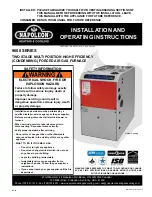
22
IM 685-1
Troubleshooting Chart
The RM7895A flame safeguard is equipped with five LEDs
to aid in the diagnosis of burner operation and problems. In
addition, a Keyboard Display Module is available and is a
valuable aid for indicating flame signal DC volts, fault mes-
s ag e s , s e qu en c e s t a t us , e t c. S e e " F l am e S a fe g ua r d
(RM7895A)" for additional information on the Keyboard
Display Module and for a description of the function of the
LEDs.
Some of the steps listed in this troubleshooting chart will be
unnecessary if a Keyboard Display Module is used, as that
module will pinpoint many problems.
BURNER MOTOR DOES NOT RUN (AFTER 10 SECOND "INITIATE" PERIOD AND WITH SWITCH AT AUTO):
1.1 Power LED is off.
a. Power is not getting to burner
1.2 Entire unit seems to be off.
a. Burner power comes from the main control panel which has a main disconnect switch, a stepdown transformer with primary
winding fuses, a 120V secondary winding fuse, and an on-off service switch. If any of these were open, the burner as well as
the supply fan would be inoperative. The control system also has firestat type temperature sensors which will shut down the
entire unit if supply or return air temperatures exceed set points. On some control systems the firestats only lock out the sup-
ply and return fans. Check main control schematic as these would not be burner problems.
1.3 Supply fan will operate.
a. Check the manual reset limit control located between the filters and the supply fan and reset if required.
b. Check that the control system has energized relay R20 located in the main control panel.
1.4 Power LED is on.
a. Push the reset button on the flame safeguard.
1.5 Resetting flame safeguard
does not start motor after
the 10 second "Initiate"
period is completed.
a. Push the reset button on the burner motor. (
Note:
If motor is hot and probably tripped, it has to cool sufficiently before it can
be reset.)
b. Test for line voltage across burner terminal 8 and NB. If powered, the problem is with the burner motor or its associated con
trols. On Models 1100-2000, terminal 8 only controls a contactor and burner motor power comes from its own circuit breaker.
If terminal 8 is dead, check for power across terminals 1 and NB.
c. IF VOLTAGE IS ZERO: The power is being interrupted by the limit control, the manual reset high or auto reset low gas pres-
sure switches (if included), or relay contacts (R20). Consult the schematic and determine the interruption.
d. If voltage is satisfactory across terminals 1 and NB and terminal 8 does not become energized after 10 seconds, and pressing
the safety reset button has no effect, replace the RM7895A.
BURNER MOTOR RUNS, BUT...
2.1 Burner motor runs valve
actuator travels to the maxi-
mum rate position and
stays there, the Keyboard
Display Module indicates
"Purge Hold".
a. Switch LS2 is not being actuated by the collar on the control rod when at the maximum rate position.
b. The air proving switch AS is not sensing burner fan pressure. Check the connecting tube, setpoint, and wiring. If LS2 and AS
are functioning, 120 volts can be measured across terminals 7 and L2 on the flame safeguard when the burner fan is running.
2.2 Burner motor runs, valve
actuator travels to the maxi-
mum rate position and
stays there, the Keyboard
Display Module goes
through the prepurge count-
down. At approximately 20
seconds, Relay (R21) does
not energize.
a. Timer TD10 is not 'making' after 20 seconds. Check that there is 120 volts on TD10 tab 1 when the actuator is at the maxi-
mum rate position. TD10 tab 2 should become energized 20 seconds after tab 1 is powered.
b. Relay R21 is not being energized by TD10, check for power across C1 and C2 after TD10 has become energized and replace
R21 if indicated.
2.3 Burner motor runs,
prepurge appears normal,
LED marked PILOT comes
on for 10 seconds, then the
flame safeguard locks out
on flame failure.
a. Flame is not igniting or is not being detected by the flame safeguard. Check that the manual gas valves are open. Check for
manifold pressure at Tap (1), Figure 16, during the 10 seconds the LED marked Pilot is on:
1. If zero, verify that there is pressure at Tap (2), Figure 16, during the same 10 second period. If so, check that LS1 is being
actuated by the collar on the control rod when at the low fire position. Check that the manual knob on GV1 is not closed
and power is supplied to valve.
2. If manifold pressure is normal, check for disconnected or shorted flame rod or ignition lead wire. Watch the ignition attempt
through inspection window on burner and check that spark is in the appropriate location. If not, this indicates a short. If
flame is observed but not detected by the flame safeguard, remove the burner gun assembly and check the flame rod,
lead wire, and connections.
3. Check the flame safeguard with a flame simulator:
a. Close main gas test cock.
b. Plug the flame simulator into the flame safeguard.
c. When the LED marked PILOT comes on, touch the simulator G post to ground. If the LED marked FLAME now comes
on, the flame safeguard is working, but it is not receiving an adequate flame signal. If the LED marked FLAME did not
come on, replace the R7847A amplifier and/or the RM7895A flame safeguard.
4. If there is spark but no flame, check for faults that would cause way too much air or too little gas.
Summary of Contents for SuperMod IM-685-1
Page 27: ...IM 685 1 27 Notes ...







































